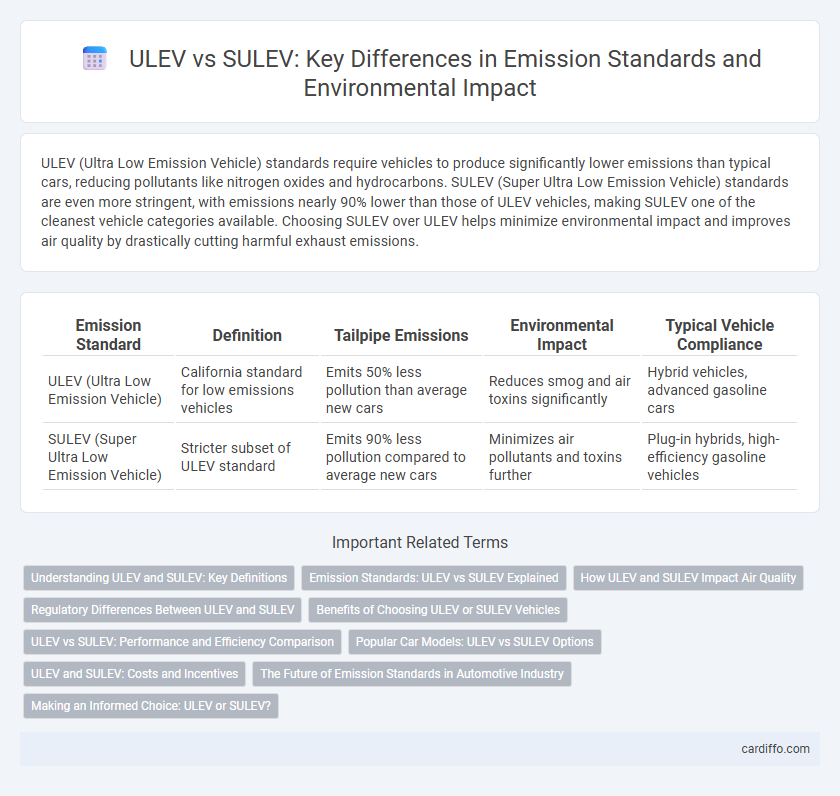ULEV (Ultra Low Emission Vehicle) standards require vehicles to produce significantly lower emissions than typical cars, reducing pollutants like nitrogen oxides and hydrocarbons. SULEV (Super Ultra Low Emission Vehicle) standards are even more stringent, with emissions nearly 90% lower than those of ULEV vehicles, making SULEV one of the cleanest vehicle categories available. Choosing SULEV over ULEV helps minimize environmental impact and improves air quality by drastically cutting harmful exhaust emissions.
Table of Comparison
| Emission Standard | Definition | Tailpipe Emissions | Environmental Impact | Typical Vehicle Compliance |
|---|---|---|---|---|
| ULEV (Ultra Low Emission Vehicle) | California standard for low emissions vehicles | Emits 50% less pollution than average new cars | Reduces smog and air toxins significantly | Hybrid vehicles, advanced gasoline cars |
| SULEV (Super Ultra Low Emission Vehicle) | Stricter subset of ULEV standard | Emits 90% less pollution compared to average new cars | Minimizes air pollutants and toxins further | Plug-in hybrids, high-efficiency gasoline vehicles |
Understanding ULEV and SULEV: Key Definitions
ULEV (Ultra Low Emission Vehicle) emits significantly fewer pollutants than conventional vehicles, typically reducing emissions by 50% or more compared to federal standards. SULEV (Super Ultra Low Emission Vehicle) represents an even stricter standard, with tailpipe emissions up to 90% lower than those of typical gasoline-powered cars. Understanding these definitions is crucial for assessing vehicle environmental impact and compliance with state and federal emission regulations.
Emission Standards: ULEV vs SULEV Explained
Ultra-Low Emission Vehicles (ULEVs) emit significantly fewer pollutants than conventional vehicles, typically producing no more than 50% of the average fleet emissions. Super Ultra-Low Emission Vehicles (SULEVs) adhere to even stricter standards, emitting 90% fewer pollutants compared to ULEVs, thereby drastically reducing harmful compounds like carbon monoxide, nitrogen oxides, and particulate matter. Regulatory agencies such as the California Air Resources Board (CARB) set these classification benchmarks to promote cleaner air and reduce the environmental impact of automotive emissions.
How ULEV and SULEV Impact Air Quality
Ultra-Low Emission Vehicles (ULEVs) reduce harmful pollutants such as nitrogen oxides (NOx) and carbon monoxide (CO) by approximately 50% compared to conventional vehicles, significantly improving urban air quality. Super Ultra-Low Emission Vehicles (SULEVs) further limit emissions, almost eliminating these pollutants with reductions exceeding 90%, thus providing cleaner air and reducing smog formation. The adoption of ULEV and SULEV technologies plays a crucial role in mitigating respiratory health issues and lowering overall environmental pollution in densely populated areas.
Regulatory Differences Between ULEV and SULEV
ULEV (Ultra Low Emission Vehicle) and SULEV (Super Ultra Low Emission Vehicle) are classified based on stringent emission standards established by the California Air Resources Board (CARB). ULEVs emit up to 50% fewer pollutants than average new vehicles, whereas SULEVs must reduce emissions by approximately 90% compared to the average, meeting more rigorous limits on hydrocarbons, nitrogen oxides, and particulate matter. Regulatory differences mandate that SULEVs undergo more frequent and detailed emissions testing, with stricter durability requirements to ensure sustained low emissions over the vehicle's lifespan.
Benefits of Choosing ULEV or SULEV Vehicles
ULEV (Ultra-Low Emission Vehicle) and SULEV (Super Ultra-Low Emission Vehicle) classifications highlight significant reductions in harmful emissions, with SULEV vehicles emitting 90% less pollutants than average new cars. Choosing ULEV or SULEV vehicles contributes to improved air quality, reduced greenhouse gas emissions, and compliance with stringent environmental regulations. These vehicles often qualify for tax incentives and access to low-emission zones, making them economically beneficial and environmentally responsible choices.
ULEV vs SULEV: Performance and Efficiency Comparison
Ultra-Low Emission Vehicles (ULEVs) produce significantly fewer emissions than conventional vehicles, while Super Ultra-Low Emission Vehicles (SULEVs) achieve even stricter emission standards by reducing pollutants by approximately 90% compared to ULEVs. In terms of performance, SULEVs often incorporate advanced catalytic converters and fuel injection systems that optimize combustion efficiency, resulting in better fuel economy and lower greenhouse gas output. Despite a marginal increase in initial cost, SULEVs deliver superior long-term savings through reduced fuel consumption and compliance with stringent environmental regulations.
Popular Car Models: ULEV vs SULEV Options
Popular car models offering ULEV (Ultra-Low Emission Vehicle) options include the Toyota Camry and Honda Accord, known for reduced emissions and fuel efficiency. SULEV (Super Ultra-Low Emission Vehicle) variants are found in models like the Chevrolet Volt and certain Toyota Prius versions, which achieve even lower emission levels through advanced hybrid or electric technologies. Consumers seeking significant emission reductions can compare these models to select vehicles that best align with environmental and regulatory standards.
ULEV and SULEV: Costs and Incentives
ULEV (Ultra-Low Emission Vehicle) models generally have lower upfront costs compared to SULEV (Super Ultra-Low Emission Vehicle) models due to less stringent emission control technologies. SULEV vehicles, while more expensive, often qualify for greater financial incentives such as tax credits and rebates aimed at promoting cleaner air standards. Consumers benefit from reduced fuel consumption and potential long-term savings with both ULEV and SULEV, but the enhanced incentives for SULEVs improve overall affordability despite their higher initial price.
The Future of Emission Standards in Automotive Industry
ULEV (Ultra-Low Emission Vehicle) and SULEV (Super Ultra-Low Emission Vehicle) represent critical benchmarks in the automotive industry's shift toward stricter emission standards. SULEV vehicles emit 90% fewer pollutants than the average new car, showcasing advancements in catalytic converters and fuel injection technologies that are pushing emission levels closer to zero. Future regulations are expected to favor SULEV and beyond, promoting electric and hydrogen fuel cell vehicles to meet increasingly stringent global carbon neutrality goals.
Making an Informed Choice: ULEV or SULEV?
Choosing between Ultra-Low Emission Vehicles (ULEV) and Super Ultra-Low Emission Vehicles (SULEV) depends on factors like emission standards and environmental impact. SULEVs emit 90% fewer pollutants than the average new car, significantly reducing smog-forming pollutants compared to ULEVs, which still produce low but higher emissions relative to SULEVs. Consumers seeking the cleanest air quality benefits should prioritize SULEV models due to their stringent emissions control technologies and compliance with the California Air Resources Board (CARB) standards.
ULEV vs SULEV Infographic

 cardiffo.com
cardiffo.com